
Moonlighter Review
Digital Sun’s Moonlighter came to Kickstarter back in May 2016, describing itself as an Action RPG with rogue-lite and shopkeeping elements. All of these things are undoubtedly true, though it becomes apparent that Moonlighter is truly something special upon the first moments of starting the game.
You play as Will, the owner of shop 'Moonlighter', which was left to him by his grandfather. The game opens with a series of easy to understand and simple tutorials that explain the combat mechanics of the game, which are also etched on the wall of the first dungeon you discover. Immediately after the start of the game, you are met with the first and only recurring NPC of any story significance. Zenon, the village elder, warns you about the dangers of the dungeons while giving little information on where they come from outside of a short exposition. Instead, he encourages Will to build his shop, suggesting that expanding Moonlighter and investing in other businesses might attract more people to the almost empty town of Rynoka.
This immediately introduces the player to two of some of the most important aspects of the game - the shopkeeping element and dungeon exploration.
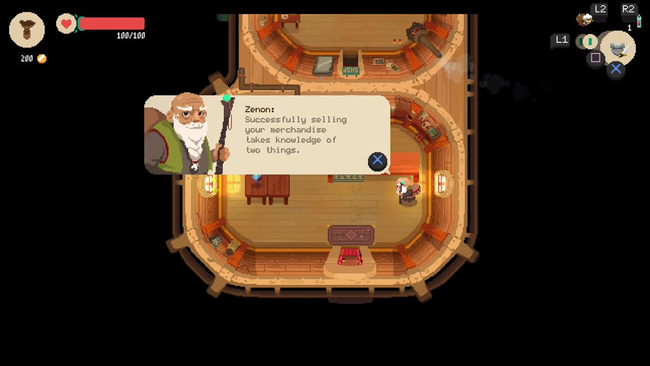
Dungeon exploration is fairly straightforward. You can choose to explore dungeons during the night or day cycle in Moonlighter. Each dungeon has a unique theme and set of enemies; all of this comes together to create a unique experience for the player, and expose them to different mechanics mirrored by the Guardian found within each dungeon itself. Dungeons themselves have a randomly generating layout so while each theme of the dungeon is in itself a constant, the layout changes upon each exit and re-entry.
Exploring dungeons at night nets the chance of players stumbling across gold chests which have a higher yield of rare materials and items, which leaves some incentive to spend your day cycles managing the shop. The difficulty of each dungeon increases as you delve deeper into them, the first level of the dungeon being the easiest, with enemies having a substantially lower amount of health, but this quickly increases as lower levels are explored. Additionally, there are secret rooms that have the potential of spawning within these randomly generated layouts which kept me on the lookout as I progressed room after room.
I learned to manage my gold and inventory space through long periods of exploration. While Will has access to the Merchant’s Pendant, which allows for players to escape with their inventory intact, it costs money to use. I was careful to make sure that the amount of money spent leaving the dungeon wouldn’t outweigh the profit of any items I had pilfered from chests or picked up from vanquished enemies. Early on I had made the mistake of just jumping into dungeons, unaware of the cost of leaving them and paid the price. There are some items that can help circumvent this that are found early on, but I still had to sacrifice rare items that I could have sold for a fair amount in response to my recklessness.
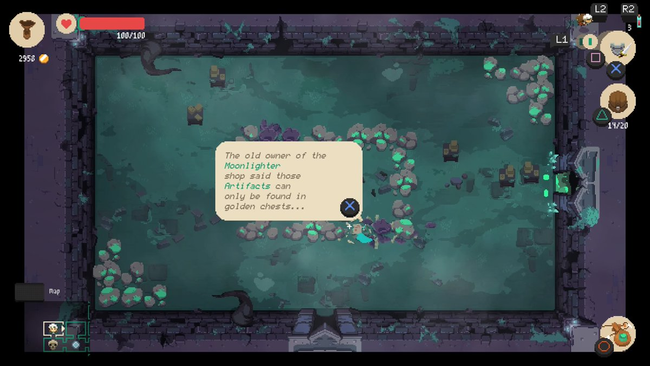
There were some instances in which I felt overwhelmed with the randomly generated enemies in a dungeon, but the challenge presented never felt unfair. Instead, I retreated with whatever I had in my inventory and went back to earlier dungeons to farm materials to make back whatever profit I might have lost. After investing in a few weapon upgrades and enchanting my armor it was easy to get back into the swing of things and resume my exploration of whatever dungeon was standing in my way. That being said, I found upgrading my weapons and armor essential for progression. However, I’m almost certain the game can be beaten without investing in either of these upgrades but I wasn’t brave enough to try it on my first run of the game.
The shopkeeping element keeps the dungeon crawling aspect of Moonlighter from growing stale. Upon returning from your excursion into the dungeons just outside of Ryoka you can man your shop during the day to sell whatever you pick up inside. As mentioned before you can only carry so much out of the dungeon with you. I quickly started to memorize or reference the notebook provided in-game to check out which items were best sold to the Merchant Mirror (a handy tool that sells items for a fraction of the actual value while inside the dungeon) and what would end up in my inventory on the way out. Once inside your shop, you can place items on the displays to sell to the citizens of Rynoka.

At first, it can be a lot of guesswork until you find the right price to sell an item at, but the notebook can help with that and the expressions that pop up above villager’s heads when they check out an item at the display. There are four types of expressions they can convey regarding how they feel about the price. Based on this, you can gauge how best to sell an item. Players can also upgrade their shop to increase the number of product displays, even adding glass cases that allow you to sell an item for almost double the normal price.
Further shop upgrades can also unlock merchant requests. Such requests allow NPCs to either ask for items from one of the dungeons or ask players to kill a certain amount of enemies. Both of these tasks have time limits that can be viewed through the calendar. Fulfilling these requests rewards the player with a hefty sum of gold and can be immensely worthwhile if you want to pursue another means of making money.
Additionally, you can add decorations to your shop. Decorations can be used to increase tips from customers or lessen the occurrence of thieves that might try to steal your wares right off of the displays. These decorations can be purchased from the Hawker, who can set up shop once you dive deeper into the dungeons and explore the town restoration mechanic.
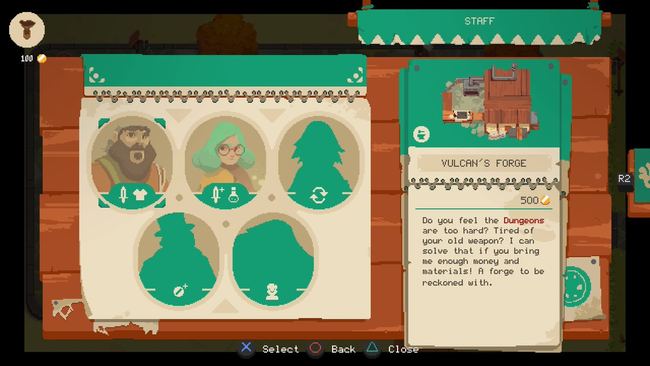
Using the money you’ve earned as shopkeeper, you can also invest in Rynoka. Using your funds to help other shopkeepers set up their businesses opens up various features like the blacksmith where you can forge weapons and armor, or the potion seller who can enchant your weapons for that extra kick. You can also invest in another shop to buy materials from if you’re pockets are fairly full and you don’t want to grind out materials in a dungeon. These encompass all of the activities the players can participate in to help restore the village or spend time outside of the dungeons.
While the story is somewhat sparse, Moonlighter allows for you to glean information from items collected in dungeons. Lore is scattered about in item descriptions, in safe havens within the dungeons once occupied by Rynoka’s Crazy Pete, and around the healing hot springs located from floor to floor in said dungeons. The player is allowed to piece together clues from these various sources. I spent much of my time poring over item descriptions and piecing together these tidbits to try and solve the mystery the narrative presented - What are the dungeons? And what was the significance of the Guardians inside of them?
Each dungeon left me pondering the significance of each area and the design of the monsters, and respective Guardian, inside. Gradually I came to my own conclusion as I explored dungeon after dungeon, happy to return to the carefully constructed and characteristic areas. Finding treasure chests and secret areas became even more exciting - not just because whatever they might hold could potentially earn me a high profit, but because they might contain tomes or other items that could reveal more lore about Rynoka and the dungeons just outside this charming little town.
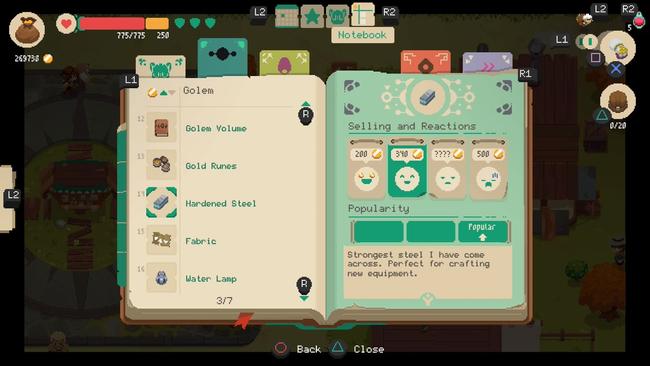
Upon completing dungeons the dialogue for the NPCs occupying the village begins to change as well, more of them coming to revere your skills as both a Merchant and a Hero, titles that carry significant weight to the local citizens. Through them, I learned more about the city itself and the difference between these two dangerous occupations. As the town grew from my increased notoriety from my heroic exploits more and more NPCs came to my village, and by the end of the game, Rynoka was once again a bustling town.
This organic growth coupled with the town building mechanic of Moonlighter made Rynoka feel like a living, breathing local with its own unique personality. The city itself is rendered beautifully in shades of green, warm browns, and oranges. Leaves rustle in the breeze and small, brightly colored birds sometimes flit across the screen or land on the roofs of nearby buildings. A clear amount of detail and care was given to the city. This could also be said for the various NPC characters in Rynoka. The 16-bit character sprites carry their own weight as NPCs walk around the city and as the player rolls or runs from shop to shop, and eventually the dungeon.
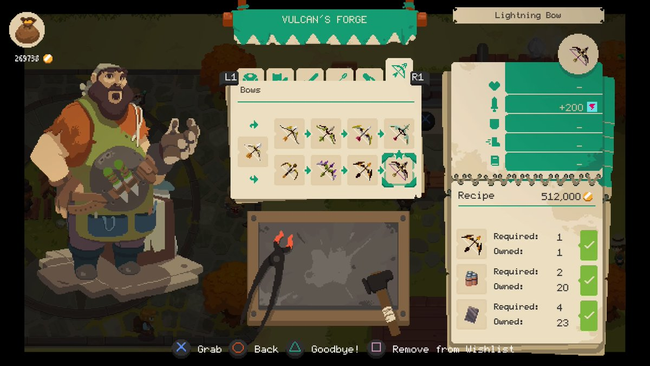
The music also played heavily into this as the titular theme of the village itself changes slightly to accompany whichever merchant you are talking with at the time. Speaking to Julien, the owner of Le Retailer, gave me some indication of his snobbish personality as sharp violins accompanied his sneering character portrait. Conversely, Andrei, the local blacksmith’s theme had more percussive notes to match his profession and give more personality to his character. Unfortunately, you can’t learn much about these shopkeepers, which is a shame as I would have liked to learn more about them and their own motivations within Rynoka. However, their designs and accompanying themes still make them memorable in their own ways.
Moonlighter is a refreshing take on the rogue-like that not only adds to the genre with the use of its shopkeeping mechanic but makes use of its rich environments and items to tell a truly interesting story. Despite some performance issues my experience with Moonlighter was extremely positive, and I can’t wait to return to Rynoka and revisit the story of Will and Moonlighter once again.